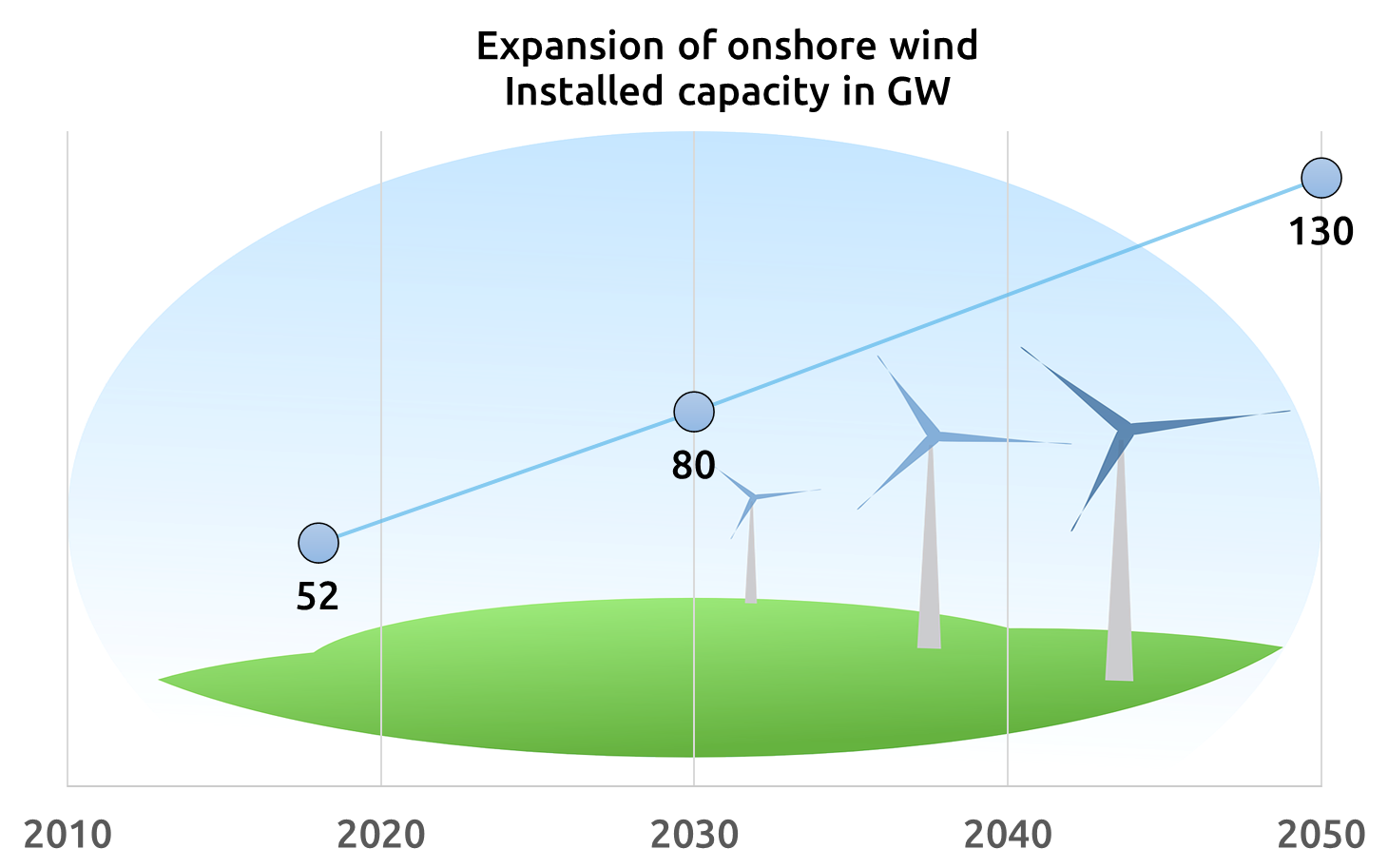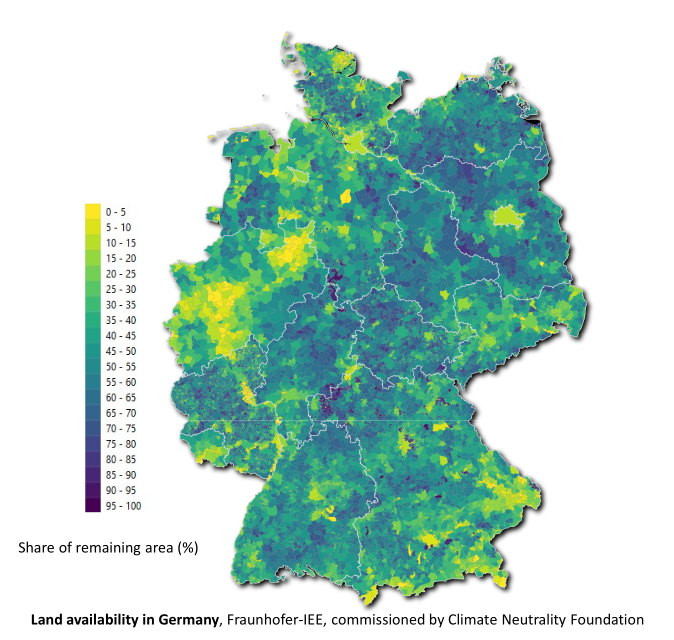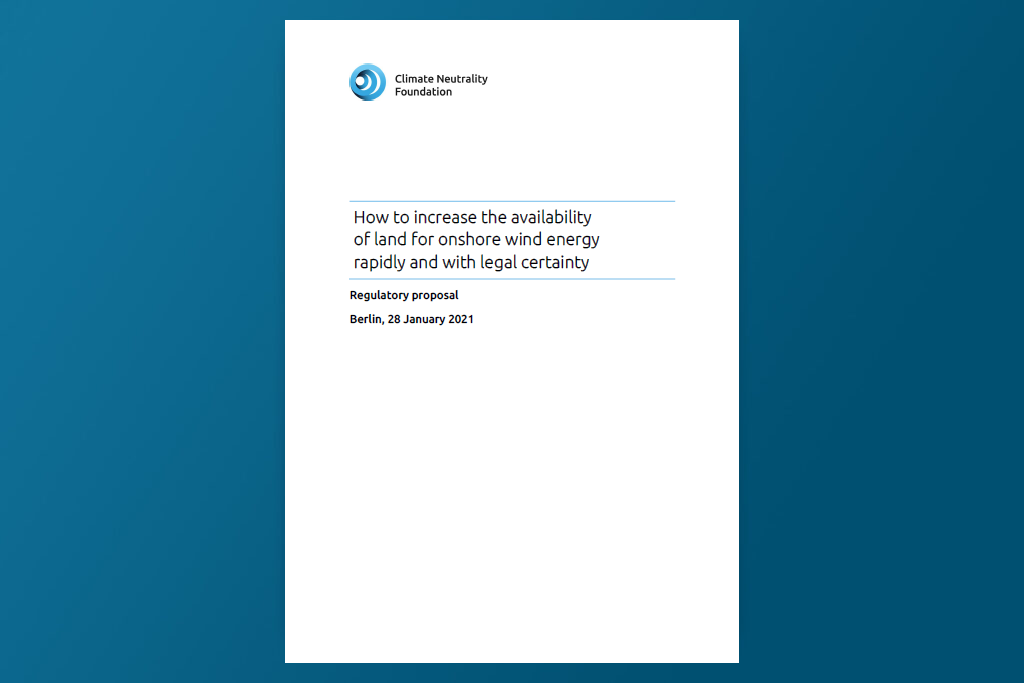
Massive expansion of wind energy necessary
On the way towards climate neutrality, wind energy will become the most important source of energy in Germany. The demand for installed onshore wind capacity will rise to 80 gigawatts by 2030 and to 130 gigawatts by 2050. Tender volumes for wind energy must be increased to 6.5 gigawatts per year.
At the end of 2020, just under 55 gigawatts had been installed. The expansion of onshore wind has slumped massively in the last three years. One of the main reasons is a lack of available land.
Target: 2% of federal land for onshore wind
According to current estimates, the transformation to climate neutrality will require an average of 2% of state and municipal land for wind energy. We are still a long way from this, with 0.9% so far. The current regulatory structure of the Federal Building Code, its application in the municipalities and the related case law of the administrative courts have not led to the provision of sufficient areas.
Our proposal
Concentration zone planning only if sufficient land is provided
The Climate Neutrality Foundation proposes a new approach towards the so-called concentration zone planning in the Federal Building Code, which can be implemented quickly (our proposal here).
The proposal is based on a legal opinion by Professor Martin Kment, an environmental and planning lawyer from Augsburg (legal opinion in German here).
With this instrument, municipalities and states can spatially control the siting of wind turbines. In doing so, they must provide sufficient space for wind energy. To end the dispute in the courts over what “sufficient” means, the Climate Neutrality Foundation proposes that the requirement be determined by the federal legislature. The required areas would be distributed among the local authorities according to a uniform procedure, and a minimum share would be determined for each municipality. In the future, concentration zone planning should only be permissible if sufficient space is provided for onshore wind.

Positive incentive for land designation
There is no obligation to plan and designate concentration zones for wind energy. However, only those concentration zone plans that correspond at least to the wind energy contribution value have an exclusion effect for wind projects in the remaining outer area. This creates a positive incentive to make sufficient areas available for wind energy.
Who is responsible for planning concentration zones, will continue to be decided locally. The planning could be done by the municipalities with land use plans, by several municipalities jointly or by the federal states with the help of regional planning.
Revenues for municipalities
Along with the regulatory proposal, the Climate Neutrality Foundation presents an overview showing what revenues municipalities can expect in the future if they push ahead with the expansion of wind energy. The EEG 2021 allows operators of new wind turbines to transfer an average of €25,000 per turbine per year to municipal budgets (presentation in German including an estimate of potential payments to municipal budgets here).
Determination of the "wind energy contribution value"
The minimum percentage to be called “wind energy contribution value” can be determined in different ways. The Climate Neutrality Foundation makes the following proposal, which takes into account that there are densely and sparsely populated communities and those with a lot and little wind:
- First, the areas that are not suitable for wind turbines are determined for each of the 11,000 municipalities in Germany according to uniform rules and based on geographic information available from the authorities. Only those areas that are uniformly excluded from wind energy use throughout Germany for legal or factual reasons are excluded, such as residential areas, nature reserves, national parks and the core zones of biosphere reserves. An analysis by the Fraunhofer Institute for Energy Economics and Energy System Technology (IEE), commissioned by the Climate Neutrality Foundation, shows that the total of all exclusion areas determined according to the uniform criteria amounts to about 57 % of the total area of the Federal Republic of Germany. Accordingly, the net remaining area is about 43 %.
- In a second step, the residual area resulting from the difference between the municipal area and the calculated exclusion area is determined for each municipality. Of this residual area, the municipalities must make a proportion available for wind energy use that corresponds in total to the required 2% of the total area. This requires an average of just under 5% of the total remaining area.
- In the third step, the “wind energy contribution value” is determined as the area size for each municipality from the calculated remaining area. In addition to the above-mentioned output value, the wind accessibility in the respective federal state is taken into account. The wind energy contribution value in communities with a lot of wind should be larger than in communities with little wind. In total, the wind energy contribution values of all municipalities correspond to 2% of the total area of Germany. As before, it is up to the local planning authorities to decide which specific areas the municipalities, regions or states actually designate for wind energy use.
Calculation results of the “wind energy contribution values” for states, districts and municipalities in Germany can be found here.
Climate Neutrality Foundation (2021)
How to increase the availability of land for onshore wind energy rapidly and with legal certainty
Regulatory proposal
Berlin, January 2021
